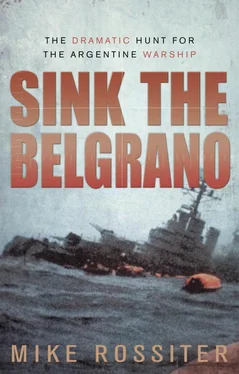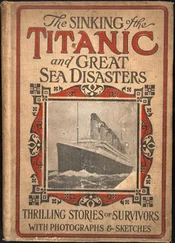The different activities of these various groups give a good indication of the talents of 6SBS, who had turned up on the quayside by HMS Conqueror . Led by their commanding officer David Heaver, 6SBS also comprised a warrant officer and three troops of four men, making fourteen extra berths to be found by Tim McClement. To add to his problems, McClement had received another signal saying that he was to expect a further thirty-six men by parachute once he was under way. He had to sit down in the wardroom with the weapons and engineering officers and work out how small a boat crew they could put to sea with in order to accommodate the extra men.
This troop of the SBS had been on winter and mountain exercises in Norway and had been ordered to make their way straight to Faslane, leaving most of their equipment and weapons to follow. The SBS can carry out a wide variety of activities, from sabotage to reconnaissance and surveillance, and Whitehall had mobilized all the Special Forces, including the SAS, on the principle that it was imperative to get them to the Falklands as soon as possible; they could worry about their specific mission later. Consequently 6SBS had a consignment of equipment that not only replaced what they had left behind in Norway, but which would enable them to undertake whatever task they might be asked to perform. There were new personal handguns and silenced machine pistols, which they had never even test-fired. There were limpet mines, demolition charges, hand grenades, rocket launchers, general-purpose machine guns and ammunition of every calibre. There was re-breathing diving equipment, allowing the user to stay under water for extended periods of time, inflatable dinghies and outboard motors, even winter camouflage suits and skis. Everything was loaded into the torpedo room of Conqueror via the weapons-loading hatch on the forward casing. It was the skis that gave the game away as far as Charlie Foy was concerned: ‘I thought, what does a freefall parachute team want with skis?’
Altogether 9 tons of equipment were brought on board by the SBS. Tim McClement was approached by a chief petty officer who pointed out that all the explosives and ammunition could not be loaded on to the boat, because under regulations each type of weapon had to be stored in its own type of locker.
The first war decision that I took [recalls McClement] was to take the regulations, put them on top of the nine tons of equipment and tell him we could say that the explosives were covered by the rules. And that was how it was going to go. A lot of the rules were going to be broken and ignored.
The equipment posed other problems for Lieutenant Commander McClement. As first lieutenant, he was responsible for the submarine’s trim – that is, its total weight and attitude in the water. This is far more critical in a submarine than on a surface ship. According to McClement, it’s an automatic, almost instinctive, action for a submariner to check the draught marks on the hull of a submarine every time he walks up the gangway: ‘I’ve never known anyone on a surface ship to bother.’ A submarine needs to have neutral buoyancy, so that if for any reason the reactor shuts down the submarine will remain at its set depth; it is highly undesirable to have it sink, and also to have it float to the surface. The weight of everything that comes on board or leaves the submarine is carefully monitored by the first lieutenant, and that includes the crewmembers. Conqueror had already taken on a large amount of food and other essential supplies – including 1,000 toilet rolls, 35 lb of laundry soap, 49,000 sheets of photocopier paper and 22 rolls of tracing paper for the plotting table in the control room. In addition to the crew’s spare equipment, they now had the extra 9 tons of equipment for the SBS. The boat was 20 tons overweight – not a large amount, but on a submarine there is almost no margin for error.
HMS Conqueror was ready to put to sea on Sunday 4 April. Slowly, she eased away from the quayside and headed for the deep waters of the Isle of Arran to do a test dive. Commander Wreford-Brown ordered the submarine to dive to 75 feet, then rise to 60 feet – a manoeuvre known as rocking the bubble – to clear any air in the ballast tanks. Then, with all hatches and compartments reporting clear of leaks, the Conqueror surfaced once more. They were going to steam down the Irish Sea on the surface to make the quickest time possible. Also, because the SBS had a completely new set of weapons, they were going to be test-fired from the top of the conning tower, or fin. This was completely in breach of safety rules, but Tim McClement knew this wouldn’t be the last peacetime regulation that they ignored. He had only one observation to make: ‘Don’t shoot at Ireland, boys – make sure you’re firing at Wales.’ So Conqueror steamed on her way, with the bow wave breaking cleanly high up the forward casing and with SBS marines taking it in turns to pour pistol and machine-gun fire into the sea. They were heading south – where, and to do what, they still didn’t know.
For years Conqueror and her crew had sped as quickly as possible northwards, to intercept a Soviet submarine, to trail it, record the slightest sound it made; then sometimes, to remind the Russian commander who was boss, they would reveal their presence before slipping away. Or they would make a careful passage into Soviet territorial waters, inching ever closer to a military base, or to a port on the Barents Sea, knowing if they were detected there would be a dangerous chase with a Russian sub or surface warship. They had trained day in and day out for the time when the Cold War with the Soviet Union became a hot one. But now they were heading into the unknown. As Commander Roger Lane-Nott said about his voyage south in HMS Splendid three days earlier, it was the wrong war, against the wrong enemy.
THE REASON WHY HMS Conqueror was steaming south down the Irish Sea, the bullets from various small arms ricocheting off the water, was that a long-running diplomatic dispute between Great Britain and Argentina about a group of small islands 8,000 miles away from London had led to bloodshed.
The Falkland Islands, or las Islas Malvinas as the Argentinians call them, consist of two main islands separated by a channel that runs roughly south-west to north-east. These islands, East Falkland and West Falkland, are surrounded by innumerable smaller islands and outcrops of rock, and their coasts are indented with many coves and inlets. They lie on the latitude of 51 degrees south, are 59 degrees to the west of Greenwich and 300 miles east of the southern tip of Argentina. Most of the roughly two thousand inhabitants, who are mainly descended from British settlers, live on East Falkland, and the biggest centre of population here is Stanley, a town on the easternmost tip of the island. What the crew of the Conqueror were going to do in the South Atlantic, although they did not yet know it, was influenced not only by the Argentine invasion of these two islands, but also the way in which that invasion had unfolded.
Everything about the Falklands is open to dispute. Samuel Johnson wrote that they were ‘a bleak and gloomy solitude, an island thrown aside from human use, stormy in winter and barren in summer… where a garrison must be kept in a state that contemplates with envy the exiles of Siberia.’ Others have said that the climate, although cold in winter, is relatively balmy, and the islands do have an average temperature higher than the UK’s.
There are even different versions of the sixteenth-century discovery of the Falklands. Some accounts claim that they were first seen by Amerigo Vespucci in 1502; others say that a ship from one of Magellan’s expeditions first encountered them. Alternatively, their first discovery was by a British ship in 1592, or perhaps by Sir Richard Hawkins two years later. There is a rare consensus, however, that they were first named the ‘Sebaldes’ by a Dutch mariner, Sebald van der Weent, in the year 1600.
Читать дальше












